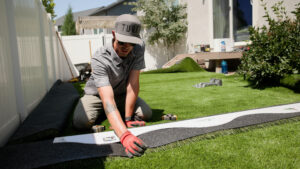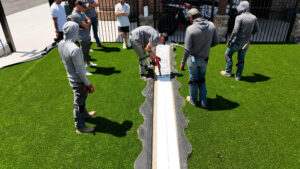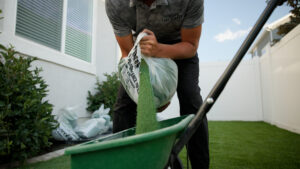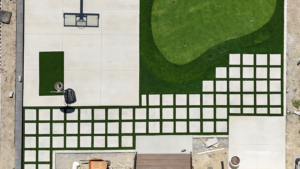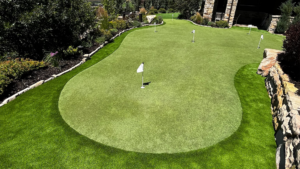When planning your artificial turf installation, understanding the relationship between pile height and density can make the difference between a mediocre lawn and a stunning landscape that enhances your property for years to come. Whether you’re considering artificial grass for a residential backyard, commercial space, or pet area, making informed decisions about artificial grass thickness and turf density will ensure your investment delivers maximum value and performance.
Artificial Turf Pile Height and Density
Pile height refers to the artificial grass height measured from the backing to the tip of the longest blade, typically ranging from .75 inches to 2.5 inches. This artificial turf height directly impacts the visual appeal, feel, and functionality of your synthetic lawn. Meanwhile, turf density measures how many individual grass fibers are packed into each square inch of backing material.
The interplay between these two factors determines your turf’s overall quality, durability, and suitability for specific applications. Higher density generally means better resilience and a more luxurious feel, while the optimal turf thickness depends on your intended use and aesthetic preferences.
Key Factors Influencing Landscape Turf Selection
Traffic Patterns and Usage
For areas expecting heavy foot traffic, choosing turf density becomes crucial. High-traffic turf solutions typically feature shorter pile heights (.75” – 1.5”) combined with higher density ratings. This combination provides excellent durability while maintaining an attractive appearance even under constant use.
Conversely, decorative areas with minimal traffic can accommodate tall fake grass options (1.5” – 2.5”) that create a lush, natural appearance. These longer artificial turf lengths offer superior visual appeal but may show wear patterns more readily in high-use zones.
Climate and Environmental Considerations
Utah and Idaho’s varied climate conditions require careful consideration when selecting artificial grass height. Shorter pile heights drain more efficiently and resist matting from snow and moisture, while taller options may require more maintenance in areas with heavy precipitation or extreme temperature fluctuations.
Pet-Friendly Requirements
When selecting the best artificial grass for pets, both pile height and density matter significantly. Medium pile heights (1” – 1.5”) paired with high density provide optimal drainage for pet waste while offering comfort for your furry friends. The turf blade length comparison shows that this range balances durability with the natural feel pets prefer.
Matching Artificial Turf Height to Your Landscape Needs
Residential Applications
- Short pile (.75” – 1.5”): Perfect for putting greens, high-traffic walkways, and play areas
- Medium pile (1.25 – 1.75”): Ideal for general landscaping, family yards, and pet areas
- Long pile (1.75” – 2.5”): Best suited for decorative spaces and low-traffic showcase areas
Commercial and Recreational Use
Commercial installations benefit from shorter, denser options that withstand constant use while maintaining professional appearance standards throughout their lifespan.
Maintenance Considerations for Different Turf Specifications
Your chosen artificial grass thickness directly impacts maintenance requirements. Taller grass may need more frequent brushing to prevent matting, while shorter options typically require less intensive care. However, higher-density turf across all pile heights tends to bounce back better from compression and maintains its appearance longer.
Consider your long-term maintenance capacity when making your selection. While tall fake grass creates a stunning visual impact, it demands more attention to preserve its appearance over time.
Frequently Asked Questions
What does pile height mean in artificial turf?
Pile height measures the artificial grass thickness from the backing material to the tip of the longest grass blade. It directly affects the turf’s appearance, feel, and performance characteristics. Shorter pile heights (.75” – 1.5”) offer durability for high-traffic areas, while taller options (1.5” – 2.5”) provide a more luxurious, natural grass appearance.
How does turf density affect durability and performance?
Turf density refers to the number of grass fibers per square inch. Higher density creates a more resilient surface that bounces back from foot traffic, resists wear patterns, and maintains its appearance longer. Dense turf also provides better support underfoot and creates a more premium feel, making it an excellent investment for long-term satisfaction.
Which artificial turf specifications work best for high-traffic areas?
High-traffic areas perform best with shorter pile heights (.75 inches – 1.5 inches) combined with high-density construction. This combination provides maximum durability while maintaining an attractive appearance under constant use. Look for turf with strong backing material and consider adding extra infill for additional support in extremely heavy-use zones.
Making Your Final Decision
The perfect turf pile height guide balances your aesthetic vision, functional requirements, and maintenance preferences. At Elite Turf Supply, we help Utah and Idaho customers navigate these choices with expert guidance and premium products that deliver lasting satisfaction.
Remember that quality artificial turf represents a significant investment in your property’s value and your family’s enjoyment. Taking time to understand these specifications ensures you’ll love your synthetic lawn for decades to come. If you’re able, come visit our warehouse to look at and feel our variety of artificial turf. We can also send samples. Take the time to make the best choice–we’re happy to help!


